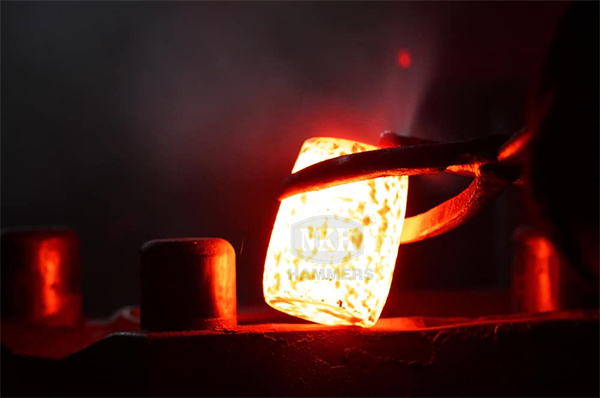What Type of Manufacturing is Forging
- Home
- What type of manufacturing is forging?
What type of Manufacturing is Forging
Forging plays a key role in metalworking. This process shapes and strengthens metals by putting pressure on them. It differs from casting or machining. Forging changes the shape of metal when it’s hot or cold. This improves its grain structure and makes it stronger. The end result? Parts that are tougher last longer, and can handle high stress. That’s why many industries choose forging when they need strong components. These include car makers, aerospace companies, construction firms, and heavy machinery manufacturers.
The Forging Process
The forging process starts with a metal workpiece a billet or ingot. This piece gets heated up to a point where it’s easier to shape, though some methods work at normal temperatures. Then, the metal faces strong pressing forces from a hammer or press to change its form. This shaping can happen with open dies (where the metal isn’t boxed in by the die) or closed dies (where the metal is pushed into a mold with specific shapes).
You can break down forging into several steps:
- Heating the Workpiece: Hot forging requires heating the metal to a specific temperature based on the material. For instance, steel heats up to around 1,100–1,300°C. This process softens the metal allowing it to change shape without breaking.
- Shaping the Metal: Next, workers place the workpiece on a die and apply compressive force. This might involve repeated controlled hits (in hammer forging) or steady pressure (in press forging). The goal is to achieve the desired shape and size by controlling how the metal flows.
- Refining the Grain Structure: Forging has an impact on the metal’s internal grain structure. The process deforms the metal causing the grains to line up with the part’s contours. This leads to better toughness more resistance to fatigue, and greater overall strength. The grain flow is a key reason forged parts last longer than cast or machined ones.
- Cooling and Finishing: After shaping the metal, it cools down. Some designs might need extra work to meet strict size limits or to improve the surface. This could involve machining or other finishing steps.

Advantages of Forging
- Better Strength: Forged parts are stronger than those made by casting or machining because the grain flow changes direction. This strength matters a lot when the material needs to handle heavy loads, stress, or impacts.
- Toughness and Ability to Resist Wear: Forging gets rid of the empty spaces and tiny holes often found in cast parts. This leads to components that can better resist wear and tear. This is key in cars and planes where safe and high-performing parts are crucial.
- Cost Efficiency for Mass Production: The initial setup for forging can cost a lot for closed-die forging that needs custom dies. However, it becomes cheaper when making large quantities. The process allows for repeated production and creates long-lasting parts. This makes it ideal to manufacture many high-strength components at lower costs per unit.
- Versatility in Materials: Forging works with many metals such as steel, aluminum, titanium, copper, and superalloys. This wide range makes it useful to produce parts in many industries, each needing different materials.
- Weight Reduction: The forging process allows manufacturers to create stronger parts with better grain structure. This means they can make components lighter without losing strength. This has a big impact on industries like aerospace and car-making where lighter parts boost performance and save fuel.
Applications of Forging
Many industries use forging to make strong parts that can handle tough situations:
- Automotive Industry: Forged parts like crankshafts connecting rods, gears, and wheel spindles play a key role in making vehicles reliable and long-lasting. These components, with their high strength-to-weight ratio, help cars perform better and use fuel more .
- Aerospace Industry: The aerospace sector relies on forged parts for engine components, landing gear, and structural elements. Forging is the go-to process to produce critical aircraft parts because it meets the tough standards for strength, weight, and resistance to wear and tear.
- Construction and Heavy Machinery: The construction industry and makers of heavy-duty machinery use forged components such as gears, shafts, and fasteners. These parts can handle heavy loads and tough working conditions, which makes them perfect for equipment like cranes and other construction machines.
- Defense and Military: The defense sector depends on forged parts for weapons, armor, and vehicles. Forged components have applications where reliability and performance under extreme stress are essential.
- Oil and Gas Industry: In the oil and gas field forged components have uses in high-pressure and high-temperature settings such as valves, flanges, and fittings where material failure is unacceptable.
Environmental Considerations
Forging has a reputation as an eco-friendly manufacturing process. It uses materials, creates less waste, and saves energy compared to other methods making it a greener option. Also forged parts last longer and are more durable, which helps sustainability by cutting down on the need to replace or fix things often.
Conclusion
Forging still plays a key role in modern industries. It can make strong long-lasting, and trustworthy parts, which makes it crucial in fields where safety, performance, and material quality matter most. As technology improves, forging keeps getting better, offering more precision better efficiency, and increased sustainability in manufacturing.

